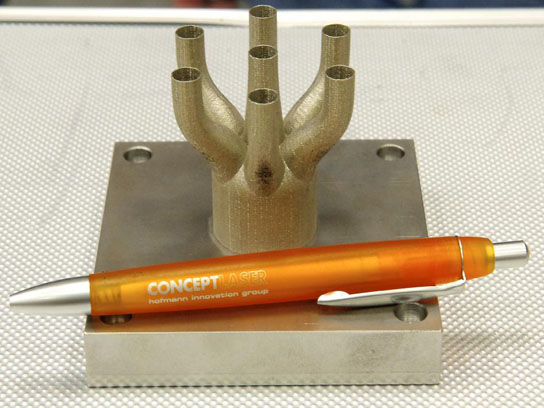NASA’s 3-D Printing of Rocket Engine Parts Might Boost Larger Manufacturing Trend
November 14, 2012

The first test piece produced on the M2 Cusing Machine — a new Selective Laser Machine recently installed in Building 4707 at the Marshall Center to be used to build parts for the Space Launch System. (Pen is included for scale.) Image credit: NASA/MSFC/Andy Hardin
NASA’s Space Launch System (SLS) is its first heavy-lift booster rocket since Saturn 5 took US astronauts to the moon. SLS will play a central role in the future of American spaceflight, but might also provide a critical test for technology expected to revamp the country’s ailing manufacturing industry.
Selective Laser Melting (SLM) is being used at NASA’ Marshall Space Flight Center in Huntsville, Alabama, to create parts for the J-2X and RS-25 rocket engines that will power the SLS, whose maiden voyage is slated for 2017. NASA expects SLM to simplify the process of making certain parts and in some cases it will halve the cost of production, provided that the components can withstand the rigors of lifting the largest launch vehicle ever built into space.
The first version of the SLS is a 70 ton rocket that will lift around 70,000 kg while providing 10% more thrust than the Saturn 5. The SLS will power the 2017 Exploration Mission 1, which will launch an unmanned Orion spacecraft on a circumlunar voyage as a precursor to Exploration Mission 2, which is scheduled for 2021. This mission will use a 130 ton SLS to launch Orion and a crew of up to 4 astronauts. This rocket will provide 20% more thrust than Saturn 5 and will lift 130,000 kg.
A state-of-the-art machine was recently delivered to NASA’s Marshall Space Flight Center in Huntsville, Ala., to create intricate metal parts for America’s next heavy-lift rocket. (NASA/MSFC)
It’s hoped that SLM will reduce the cost of the program. SLM is a type of additive manufacturing technology, it uses a finely powdered alloy is deposited in a layer as thin as 20 microns and then fused together by a focused laser beam inside a chamber containing inert gas. Once the laser has turned a layer into solid metal, another layer of powder is deposited and the process is repeated.
NASA is currently testing the viability of making engine parts from nickel-based alloys using SLM. The same alloys are used to make 90% of the parts in the RS-25 and the J-2X engines. But a key difference is that the engines’ elements are forged and milled into their final shapes and often several pieces have to be welded together to create a part.
In 2010, Marshall engineers began alternative approaches to building parts for the next-generation J-2X engine. SLM was used to great a duct for a gas generator in the engine. The part itself isn’t complex, but because of the thickness and the radius of the bend, it’s a very difficult part to make.
Although the SLM part wasn’t as strong as the forged and milled duct, it fell within the minimal acceptable range. However, this part required no welding, meaning that it could have more structural strength.
More testing is needed whether these components will function in the most intense conditions and if they can be properly made using SLM. Parts with complex geometries that are difficult to make and require multiple welds are good candidates.
No comments:
Post a Comment